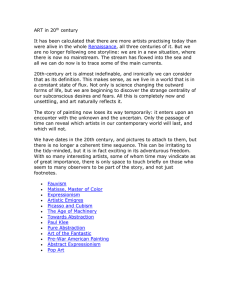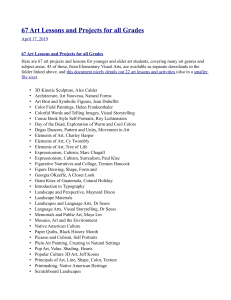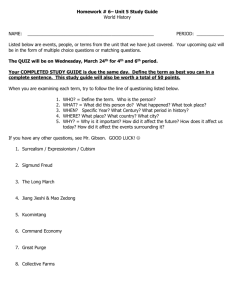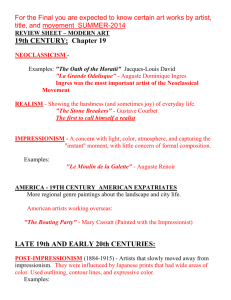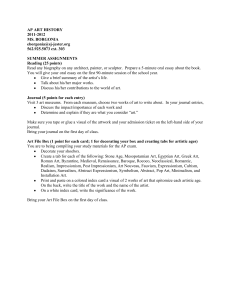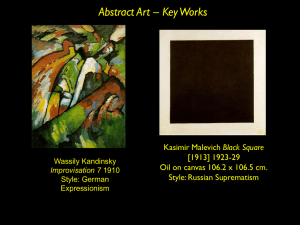ART APPRECIATION - 20th Century Art Movement
advertisement
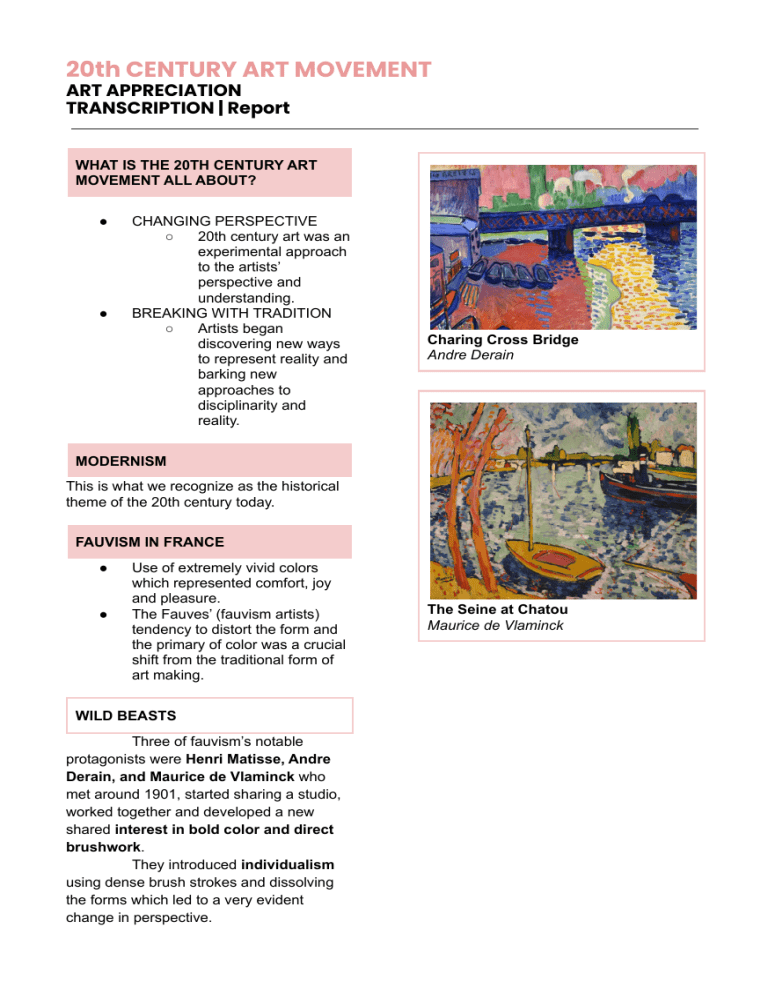
20th CENTURY ART MOVEMENT ART APPRECIATION TRANSCRIPTION | Report WHAT IS THE 20TH CENTURY ART MOVEMENT ALL ABOUT? ● ● CHANGING PERSPECTIVE ○ 20th century art was an experimental approach to the artists’ perspective and understanding. BREAKING WITH TRADITION ○ Artists began discovering new ways to represent reality and barking new approaches to disciplinarity and reality. Charing Cross Bridge Andre Derain MODERNISM This is what we recognize as the historical theme of the 20th century today. FAUVISM IN FRANCE ● ● Use of extremely vivid colors which represented comfort, joy and pleasure. The Fauves’ (fauvism artists) tendency to distort the form and the primary of color was a crucial shift from the traditional form of art making. WILD BEASTS Three of fauvism’s notable protagonists were Henri Matisse, Andre Derain, and Maurice de Vlaminck who met around 1901, started sharing a studio, worked together and developed a new shared interest in bold color and direct brushwork. They introduced individualism using dense brush strokes and dissolving the forms which led to a very evident change in perspective. The Seine at Chatou Maurice de Vlaminck EXPRESSIONISM IN GERMANY ● ● ● ● Expressionism is an art movement that emerged in early 20th century German Expressionism focuses on the artists’ emotion and self-expression. It favored subjectivity over reality depiction using different techniques It struggled to acquire a significance as a movement since there were a lot of art movements that emerged with expressionism because of devastating events such as World War I. Klange Wassily Kandinsky Der Wasserfall Franz Marc SENECIO 1992 Paul Klee He is a Swiss-born German artist. His highly individual style was influenced by movements in art that included expressionism, cubism, and surrealism. Self Portrait I Marianne von Werefkin BLUE CREST Wassily Kandinsky He founded the Der Blaue Reiter art movement, one of the most influential groups of German Expressionism. CUBISM ● ● ● ● Cubism is considered to be the first abstract movement. The founding artists found a new approach in representing reality by creating a similar but distorted imagery in a two-dimensional manner. It emphasizes geometric shapes After 1918, cubist paintings have already become part of a more conservative stream, since painting itself was facing a critical point Les Demoiselles d`Avignon Pablo Picasso Established the cubism movement in the early 20th century. PABLO PICASSO ● Picasso also helped invent Cubism and collage. The new techniques he brought to his graphic works and ceramic works changed the course of both art forms for the rest of the century. The Weeping Woman Pablo Picasso GEORGES BRAQUE ● Braque entered what is called a synthetic phase of Cubism. He began to use more colors and to represent objects through large planes. The Bird Seller Vicente Manansala FUTURISM ● ● Futurism was inspired by cubism as a style. Futurism emphasized ○ energy, ○ dynamism, ○ industry, ○ speed, ○ and technology The Blue Dancer Gino Severini Flippo Tommaso Marinetti invented and led the futurism art movement Dynamism of a Car Luigi Rossolo Umberto Boccioni - During his short life, he produced some of the movement's iconic paintings and sculptures. Primavera Umbria Gerardo Dottori NEGOTIATING ABSTRACT ART SUPREMATISM, NEOPLASTICISM, BAUHAUS SCHOOL TOTAL REDUCTION OF SHAPE AND FORM All of the movements from the 1900s and 1910s led to a total reduction of shape and form SUPREMATISM NEOPLASTICISM: DE STIJL “The Modern Plastic Art Movement” De stijl means “The Style” was conceived in 1917 in the Netherlands by a group of artists who had an idea to understand the purity of form and the reality of nature. The style was called Neoplasticism or the new plastic art which aimed to develop a universal language without hidden meanings and a form of purism that is based on shapes and three primary colors. Those who were not inclined to affiliate art with life joined Kazimir Maljevis and his concept of the “supremacy of the pure artistic feeling” embodied through this Focused on pure abstraction with the use of fundamentals of geometry (circles, squares, **rectangles) Composition II in Red, Blue, and Yellow of Piet Mondrian Composition VII (The Three Graces) of Theo van Doesburg “Suprematism” of Kazimir Malevich Beat the Whites with the Red Wedge of Elizar Lissitzky BAUHAUS SCHOOL A school founded in 1919 which stood as a representative of an all-encompassing style that conjoined ideas from opposing styles Aimed to merge intellectualized art with manufacture DADAISM Dadaism was the pioneer of anti-art. It is playful and highly experimental art. Dada was never restricted by anything and everything happens in a completely “idiotic way” SURREALISM Surrealists claim to create form and images not primarily by reason but by unthinking impulse Surrealists declare that a magical world is more beautiful than that of the real one. It appeared as a response to the dadaist activities from before. L.H.O.O.Q. Marcel Duchamp French painter Marcel Duchamp joined the Dada movement by painting a mustache on a reproduction of Mona Lisa. It was an ingenious assault on tradition and a public that had lost the humanistic spirit of Renaissance Andre Breton had the right over the term Surrealism as he is more eloquent as he implemented this movement and actively contributed to the scene and surrealist theory. Egg in the Church of the Snake Andre Breton Premier Promenade Man Ray The Persistence of Memory Salvador Dali The Bride Stripped Bare by Her Bachelors, Even Marcel Duchamp and Rrose Selavy The Tilled Field Joan Miro ABSTRACT EXPRESSIONISM POP ART Abstract Expressionism was more of a philosophy than a name for a unified visual identity. A direct response to the over-intellectualized high art (Abstract Expressionism, that is). It was the first internationally acclaimed influential movement to originate in America. It is an idea to merge low art and high art ● Low art refers to arts that are meant for the masses and are for mere entertainment while high arts need background knowledge on history in order to appreciate it. ● High arts are usually for those who have participated in an educated and informed way in the cultural dialog about art WORLD WAR II Before and during the Second World War, many creatives moved from Europe and found refuge in the United States. Incidentally, it was the period in which Abstract Expressionism emerged in America. War is often associated with this style Pop Art involved highly figurative motives and objects from popular culture, speaking to the broader audiences in a more relatable, familiar language. One of the most distinct styles, and it became a highly collectible, commercial type of art that indeed was respected both by high art institutions and the masses. Autumn Rhythm Jackson Pollock The Liver is the Cock’s Comb Arshile Gorky Still Life 35 Tom Wesselman 3 FLAGS Jasper Johns Woman I William de Kooning Marilyn Dyptych Andy Warhol 1960s - PROTESTS, REVOLUTIONS, CONCEPTUAL ART ONE AND THREE CHAIRS Joseph Kosuth It was a revolutionary organization with an ideology of Black nationalism, socialism, and armed self-defense, particularly against police brutality.. ONE AND THREE SHOVELS Joseph Kosuth STREET ART BEGAN TO APPEAR ALONG THE STREETS OF NEW YORK FOUNTAIN Marcel Duchamp It is true that women were present in art history both as artists and models, but only the latter is widespread and offers plenty of information, while the former barely stands ground. CONTEMPORARY ART, POST-CONCEPTUAL ART LATE 20TH CENTURY AND THE 21ST CENTURY The term “contemporary arts” came into use, in order to try to classify different types of art that coexist at the same time. NON-MATERIAL ART The confusing term contributes to the fragmentation of all the various types of artworks we can see in the 21st century. During this era, Non-material art that favors the idea over the material product gave rise to Performance and Land Art. PERFORMANCE AND LAND ART One example is Marina Abramovic’s Rhythm Zero which was a six-hour work of performance art. Peter Osborne prefers the term post-conceptual rather than contemporary to describe today's prevalent artistic practices. ART WAS NO LONGER STRICTLY RELATED TO GALLERIES Art-making was no longer strictly related to galleries indeed, and many new types of non-art and anti-art appeared. Galleries are still pretty much as white as ever, meaning that conceptual art was eventually silenced or transformed by the art market. SEALED COMPUTERS Maurizio Bolognini THE BIRTH OF THE VIRACTUAL Joseph Nechvatal Computer-robotic assisted acrylic on canvas ARTWORKS ARE GETTING MORE EXPENSIVE EACH DAY Artworks are getting more expensive each day - even the ones produced by conceptual artists from the 60s - and the market just keeps on growing (while everything else seems to go down).
